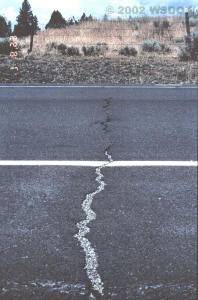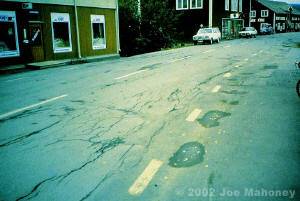Environment
A pavement must function within its environment. The environment can vary greatly across the State at any one time and it can also vary greatly throughout time at any one place. Environmental variations can have a significant impact on pavement materials and the underlying subgrade, which in turn can drastically affect pavement performance. The key environmental parameters of concern are typically temperature, frost action and moisture.
Temperature
Temperature acts on pavements in two principal ways. First, temperature extremes can affect asphalt binder rheology. Second, temperature variations can cause pavement to expand and contract.
Temperature Extremes
Asphalt binder rheology varies with temperature. Therefore, estimated temperature extremes and their effects are a primary consideration when selecting an appropriate asphalt binder. For flexible pavements, older asphalt binder grading systems did not directly account for temperature effects and thus various empirical systems and thumb-rules were developed. The Superpave PG binder grading system corrects this deficiency by grading asphalt binder based on its performance in relation to temperature.
Expansion and Contraction
Pavements, like all other materials, will expand as they rise in temperature and contract as the fall in temperature. Small amounts of expansion and contraction are typically accommodated without excessive damage, however extreme temperature variations can lead to catastrophic failures. Flexible pavements can suffer longitudinal cracks as a result of excessive contraction in cold weather.

Figure 1: Cracks From Excessive Pavement Contraction

Figure 2: Cracks From Excessive Pavement Contraction
Frost Action
Frost action, which can be quite detrimental to pavements because of its effect on the underlying subgrade, can be divided into “frost heave” and “thaw weakening”. “Frost heave” is an upward movement of the subgrade resulting from the expansion of accumulated soil moisture as it freezes, while “thaw weakening” is a weakened subgrade condition resulting from soil saturation as ice within the soil melts.
WAPA Pavement Note on Frost Action
Frost action is generally not a concern west of the Cascade Mountains.
Frost Heave
Frost heaving of soil is caused by crystallization of ice within the larger soil voids and usually a subsequent extension of this ice to form continuous ice lenses, layers, veins, or other ice masses. As depicted in Figure 3, An ice lens grows and thickens in the direction of heat transfer until the water supply is depleted or until freezing conditions at the freezing interface no longer support further crystallization. As the ice lens grows, the overlying soil and pavement will “heave” up potentially resulting in a rough, cracked pavement (Figure 4).
Frost heave occurs primarily in soils containing fine particles (often termed “frost susceptible” soils), while clean sands and gravels (small amounts of fine particles) are non-frost susceptible (NFS). Thus, the degree of frost susceptibility is mainly a function of the percentage of fine particles within the soil. Many agencies classify materials as being frost susceptible if 10 percent or more passes a No. 200 sieve or 3 percent or more passes a No. 635 sieve.


Figure 4: Frost Heave
Pavement Note: the Casagrande Criterion
In 1932, Dr. Arthur Casagrande proposed the following widely known rule-of-thumb criterion for identifying potentially frost susceptible soils:”Under natural freezing conditions and with sufficient water supply one should expect considerable ice segregation in non-uniform soils containing more than 3% of grains smaller than 0.02 mm, and in very uniform soils containing more than 10 percent smaller than 0.02 mm. No ice segregation was observed in soils containing less than 1 percent of grains smaller than 0.02 mm, even if the groundwater level is as high as the frost line.”Note: 0.02 mm = No. 635 sieve. Application of the Casagrande criterion requires a hydrometer test of a soil suspension (in water) to determine the distribution of particles passing the #200 sieve and to compute the percentage of particles finer than 0.02 mm.
Thaw Weakening
Thawing weakening occurs when the ice contained within the subgrade melts. As the ice melts and turns to liquid it cannot drain out of the soil fast enough and thus the subgrade becomes substantially weaker (less stiff) and loses bearing capacity. Therefore, loading that would not normally damage a given pavement may cause significant damage during spring thaw.
Thawing can proceed from the top downward, or from the bottom upward, or both. How this occurs depends mainly on the pavement surface temperature. During a sudden spring thaw, melting will proceed almost entirely from the surface downward. This type of thawing leads to extremely poor drainage conditions. The frozen soil beneath the thawed layer can trap the water released by the melting ice lenses so that lateral and surface drainage are the only paths the water can take.
Mitigating Frost Action
Frost action mitigation generally involves structural design considerations as well as other techniques applied to the base and subgrade to limit its effects. The basic methods used can be broadly categorized into the following techniques:
Frost Heave
- Limit the depth of frost into the subgrade soils. This is typically accomplished by specifying the depth of pavement to be some minimum percentage of the frost depth. By extending the pavement section well into the frost depth, the depth of frost-susceptible subgrade under the pavement (between the bottom of the pavement structure and frost depth) is reduced. The assumption is that a reduced depth of soil under frost action will cause correspondingly less damage.
- Remove and replace frost-susceptible subgrade. Ideally the subgrade will be removed at least down to the typical frost depth. Removing frost-susceptible soils removes frost action.
- Provide a capillary break. By breaking the capillary flow path, frost action will be less severe because frost heaving requires substantially more water than is naturally available in the soil pores.
WAPA Pavement Note on Frost Heave Mitigation
WSDOT mitigates frost heave by specifying that the total depth of the pavement structure must equal one-half the expected depth of frost.
Thaw Weakening
- Design the pavement structure based on reduced subgrade support. This method simply increases the pavement thickness to account for the damage and loss of support caused by frost action.
- Restrict pavement loading during thaw conditions. Permanent pavement damage can be limited by limiting pavement loading while the subgrade support is weak. Typically, a load reduction in the range of 40 to 50 percent should accommodate a wide range of pavement conditions.
Moisture
Moisture (in the form of accumulated water or rainfall) can affect pavement design and construction as well as basic driving conditions.
- Design. Certain types of soils can be highly expansive when wet. Structural design must account for this expansiveness.
- Construction.
- Subgrade should be compacted at an optimal moisture content. Excessive rainfall can raise subgrade moisture content well beyond this value and make it virtually impossible to compact.
- HMA should not be placed in wet conditions because excessive water may damage the hot, fresh HMA.
- Driving Conditions. Rainfall reduces skid resistance and visibility, and can cause hydroplaning in severely rutted areas.
Design Factors



